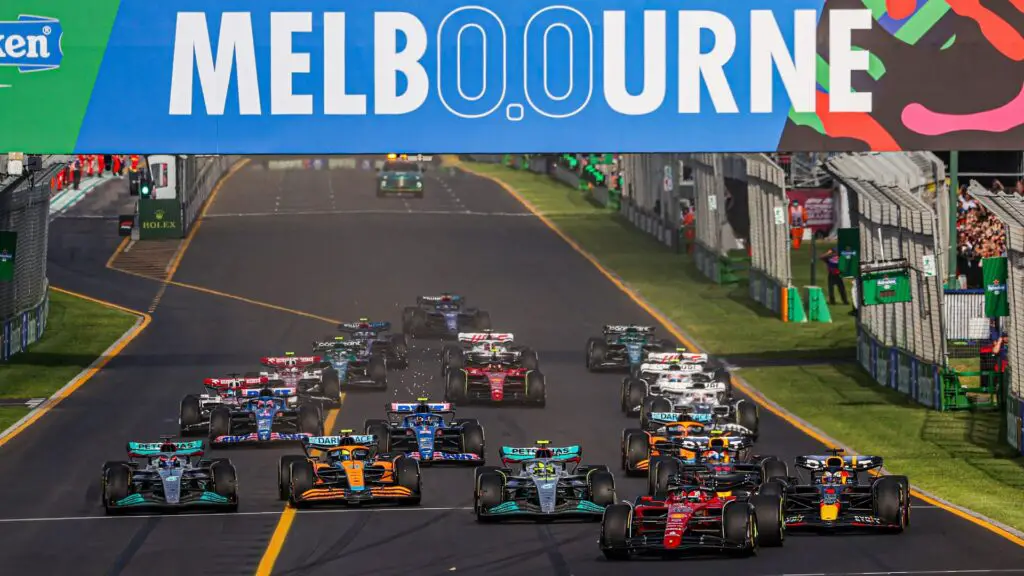Welcome to the ultimate guide to the F1schedule! If you’re a fan of high-speed thrills, adrenaline-fueled races, and the world’s most talented drivers, you’re in for a treat.
Read on as we take you on a journey through the exhilarating world of F1, providing you with all the information you need to stay up-to-date with the latest races, dates, locations, and highlights. From iconic tracks like Monaco and Silverstone to the new ones, we’ve got you covered.
Get ready to immerse yourself in the electrifying atmosphere of the F1schedule. We delve into the heart-pounding moments, fierce rivalries, and unexpected plot twists that make Formula One racing a global phenomenon.
Whether you’re a seasoned fan or new to the sport, this guide will equip you with everything you need to become a true F1 aficionado. So, buckle up and let’s dive into the fast-paced world of the F1schedule!
Understanding The F1 Championship
Formula One, or F1, is the pinnacle of motorsport. It is a global championship that attracts millions of fans from around the world. The F1 championship consists of a series of races held on various tracks across the globe. Each race is a battle between the world’s best drivers, competing for the coveted title of F1 World Champion.
The F1 championship follows a point system. The drivers and teams earn points based on their finishing positions in each race.
Winning the most points by the end of the F1schedule makes the driver World Champion. The team with the most points wins the Constructors’ Championship.
Formula One uses cutting-edge technology, with teams constantly pushing the boundaries of engineering and innovation. The Engineers design the F1 cars for speed. This includes the aerodynamics to engine performance, every aspect of an F1 car is meticulously .
The combination of skill, strategy, and sheer speed makes F1 racing a thrilling spectacle that captivates fans worldwide.
The F1Schedule
The F1schedule is a carefully curated collection of races that take place throughout the year. The calendar is subject to change from season to season, with new tracks being added and existing tracks being modified or removed.
The FIA usually announces the details of the next years season months in advance. It gives fans ample time to plan their trips and mark their calendars.
The F1schedule is a mix of iconic tracks and new additions that aim to bring the excitement of F1 racing to different parts of the world. From historic circuits like Monza in Italy to modern tracks like Yas Marina in Abu Dhabi, each race offers a unique experience for fans and drivers alike.
The calendar typically includes around 20 races, spanning multiple continents. F1 runs races in diverse locations, from bustling city streets to picturesque countryside settings.
Each race brings its own challenges, with varying track layouts, weather conditions, and fan atmospheres. The F1 calendar is a carefully crafted tapestry of thrilling races that showcase the best of motorsport.
Key Dates and Locations for the F1Schedule

The F1 season kicks off with the Australian Grand Prix, held in Melbourne in March. This race sets the stage for the rest of the season, giving fans a taste of the action to come.
From there, the F1 circus travels the globe, with races in Asia, Europe, the Americas, and the Middle East.
One of the highlights of the F1 calendar is the Monaco Grand Prix, held on the streets of Monte Carlo. It’s reputation is being a narrow and challenging circuit, as well as its glamorous setting. The Monaco Grand Prix is a must-see for any F1 fan, offering a unique blend of sporting excellence and high society.
Another highlight is the British Grand Prix, held at the historic Silverstone Circuit. This race is a favorite among fans and drivers alike, with its fast and flowing layout providing plenty of overtaking opportunities.

The British Grand Prix is steeped in tradition and has a rich history, making it a true spectacle for motorsport enthusiasts.
In recent years, new tracks have been added to the F1 calendar, expanding the reach of the championship. Races in countries like Saudi Arabia have brought F1 to new audiences, further cementing its status as a global sport.
These new additions add excitement and unpredictability to the schedule, as drivers and teams navigate unfamiliar terrain.
For a full schedule of the 2023 F1 Season follow this link.
Highlights and Must-Watch Races In The F1Schedule
While every race on the F1 calendar is worth watching, there are some that stand out as must-see events. These races often have a combination of thrilling track layouts, historic significance, and fierce competition that make them unforgettable.

The Italian Grand Prix, held at Monza, is one such race. Known as the “Temple of Speed,” Monza is the fastest track on the calendar, with long straights and high-speed corners. The Italian Grand Prix is steeped in history, with legendary drivers like Michael Schumacher and Ayrton Senna leaving their mark on this iconic circuit.
Another race that should not be missed is the Belgian Grand Prix, held at the legendary Spa-Francorchamps circuit. This track is a favorite among drivers for its challenging layout and unpredictable weather conditions. The Belgian Grand Prix has produced some of the most memorable moments in F1 history, with its fast corners and thrilling overtakes.
For fans looking for a unique experience, the Singapore Grand Prix offers a night race on the streets of Marina Bay. The Singapore Grand Prix is a spectacle of lights and sounds, with the city skyline providing a stunning backdrop for the race. The tight and twisty circuit makes for intense racing, as drivers navigate the challenging conditions under the floodlights.
The History of F1 Grand Prix Races
Formula One has a rich and storied history, with its origins dating back to the 1950s. The first World Championship race was held in 1950 at Silverstone, marking the beginning of a new era in motorsport. Since then, F1 has grown in popularity and evolved into the global championship we know today.
Over the years, F1 has witnessed some of the greatest drivers and rivalries in the history of motorsport. From the fierce battle between Alain Prost and Ayrton Senna in the late 1980s to the dominance of Michael Schumacher in the early 2000s, there have been countless iconic moments that have shaped the sport.
The F1 calendar has also seen changes over time, with new tracks replacing old ones and races moving to different locations. Some races have become synonymous with F1, like the Monaco Grand Prix and the Italian Grand Prix, while others have come and gone, leaving behind a legacy of thrilling races and unforgettable moments.
How to Attend an F1 Race
Attending an F1 race is a bucket-list experience for many fans. The electrifying atmosphere, the roar of the engines, and the sight of the world’s best drivers battling it out on track are all part of the unique F1 experience. If you’re planning to attend a race, here are some tips to help you make the most of your trip.
First, decide which race you want to attend. Consider factors like the location, the track layout, and the historic significance of the race. Each race offers a different experience, so choose one that aligns with your preferences.
Once you’ve chosen a race, start planning your trip well in advance. F1 races attract a large number of fans, so accommodation and travel options can get booked up quickly. Research the best places to stay near the track and make your reservations as early as possible.
When attending an F1 race, it’s important to come prepared. Pack comfortable clothing and footwear, as you may be walking long distances and standing for extended periods. Bring earplugs to protect your hearing from the deafening noise of the engines. And don’t forget to bring your camera to capture all the action!
Tips for Planning Your F1 Trip

Planning a trip to an F1 race can be overwhelming, but with the right preparations, it can be a seamless and enjoyable experience. Here are some tips to help you plan your F1 trip:
- Research the race: Learn about the track layout, the best viewing spots, and the local attractions. This will help you make the most of your time at the race.
- Book accommodation early: F1 races attract a large number of fans, so it’s important to book your accommodation well in advance. Look for hotels near the track or in the city center, depending on your preferences.
- Plan your travel: Consider the best mode of transportation to reach the race venue. If flying, book your tickets early to secure the best prices. If driving, plan your route and check for any road closures or traffic restrictions.
- Check visa requirements: If you’re traveling to a foreign country for an F1 race, make sure to check the visa requirements well in advance. Apply for the necessary visas and ensure your passport is valid for the duration of your trip.
- Pack essentials: Don’t forget to pack essentials like sunscreen, a hat, comfortable clothing, and earplugs. These will ensure you have a comfortable and enjoyable experience at the race.
- Familiarize yourself with the schedule: Take note of the race schedule, including practice sessions, qualifying, and the main race. Arrive early to secure a good viewing spot and make the most of your time at the track.
TV and Streaming Options for Watching F1
If you can’t attend an F1 race in person, there are plenty of TV and streaming options available to watch the action from the comfort of your own home.
F1 races are broadcasted live on various television networks around the world, providing fans with a front-row seat to the excitement.
In addition to traditional television broadcasts, there are also streaming services that offer live coverage of F1 races. These streaming platforms allow fans to watch races on their computers, smartphones, or other devices, giving them the flexibility to tune in from anywhere.
To access F1 coverage, you may need a subscription to a sports channel or streaming service that has the broadcasting rights for F1 races in your region. Some streaming platforms offer free trials, allowing you to test the service before committing to a subscription.
Conclusion
The F1 schedule is a thrilling journey through the world of motorsport. From the iconic tracks to the fierce rivalries, each race offers its own unique blend of excitement and adrenaline.
Whether you’re attending a race in person or watching from home, the F1 calendar promises a spectacle that captivates fans around the world. With this ultimate guide, you now have all the information you need to stay up-to-date with the latest races, dates, locations, and highlights.
So, buckle up and get ready for the heart-pounding action of the F1 season!

